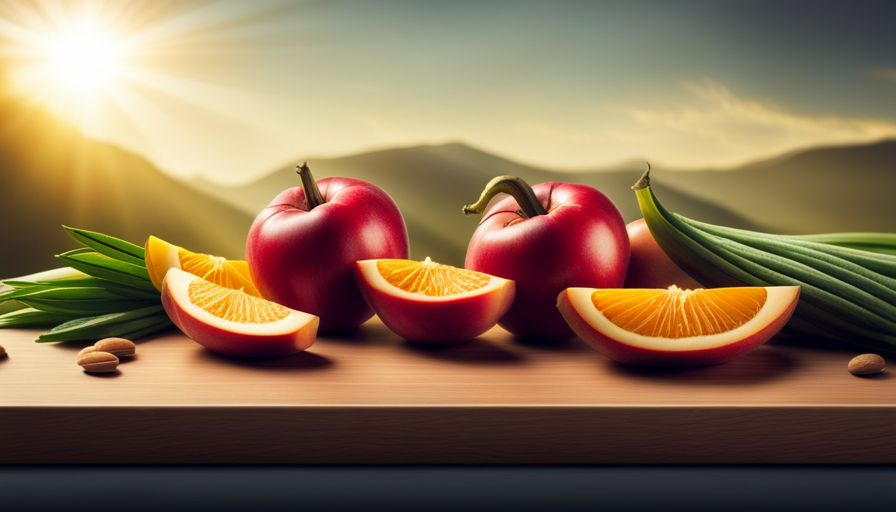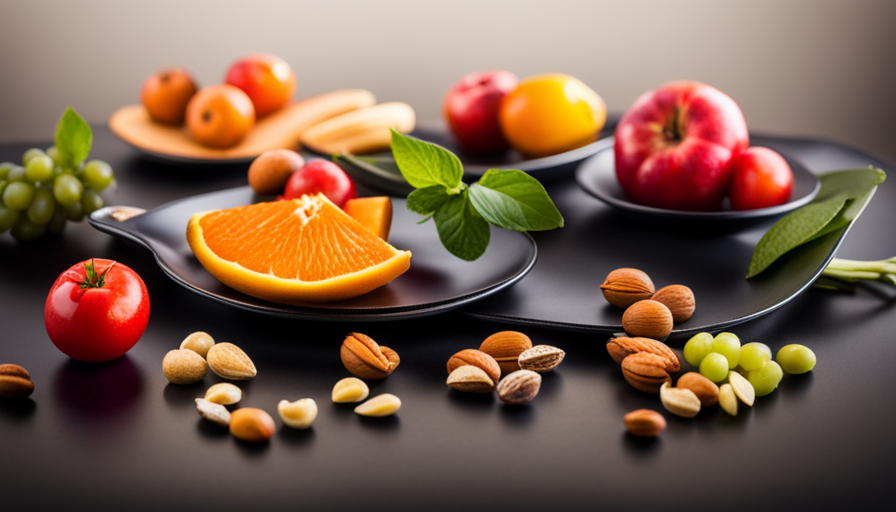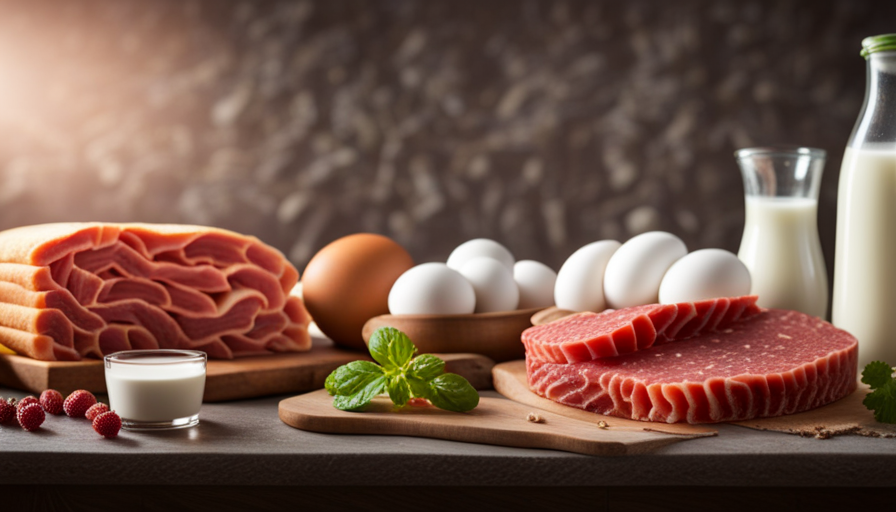Are you fed up with the traditional diets that claim to offer quick solutions but ultimately leave you feeling unfulfilled and drained? Get ready to be amazed because I have uncovered the ultimate nutrition secret – the raw food diet!
This revolutionary approach to eating will not only transform your health but also ignite a passion for food like you’ve never experienced before.
So, what does a raw food diet mean exactly? It’s simple: it’s a dietary lifestyle that primarily consists of consuming unprocessed, uncooked, and organic foods. By embracing the power of nature’s bounty, you’ll nourish your body with a vibrant array of fruits, vegetables, nuts, and seeds that are brimming with essential vitamins, minerals, and enzymes.
But the benefits of a raw food diet go beyond just physical health. You’ll experience increased energy levels, improved digestion, enhanced mental clarity, and even weight loss. Plus, it’s a sustainable and eco-friendly way of eating that promotes a harmonious relationship with our planet.
If you’re ready to embark on a journey of wellness and vitality, join me as we explore the ins and outs of a raw food diet. Together, we’ll uncover the science behind this transformative approach, hear inspiring success stories, and discover expert recommendations.
Get ready to revolutionize your health and embrace a raw food lifestyle like never before!
Key Takeaways
- Raw food diet consists of consuming unprocessed, uncooked, and organic foods.
- Benefits of raw food diet include increased energy levels, improved digestion, enhanced mental clarity, and weight loss.
- Components of raw food diet include fruits and vegetables, nuts and seeds, and sprouts and fermented foods.
- Potential risks of raw food diet include nutritional deficiencies, bacterial contamination, and difficulty meeting caloric needs.
Definition of a Raw Food Diet
So, what does a raw food diet really mean for you? A raw food diet is a dietary approach that primarily consists of consuming uncooked, unprocessed, and plant-based foods. This includes fruits, vegetables, nuts, seeds, and sprouted grains. The idea behind this diet is that cooking food can destroy essential nutrients and enzymes, leading to a loss of its nutritional value.
There are several health benefits associated with a raw food diet. Firstly, since raw foods are typically low in calories and high in fiber, they can aid in weight management and promote a healthy digestive system. Additionally, raw foods are rich in vitamins, minerals, and antioxidants, which can boost immunity, reduce inflammation, and prevent chronic diseases such as heart disease and certain types of cancer.
However, it is important to note that a raw food diet also comes with potential risks. Raw foods may be contaminated with harmful bacteria and parasites, increasing the risk of foodborne illnesses. It can also be challenging to meet all of your nutritional needs on a raw food diet, especially for certain vitamins and minerals like vitamin B12 and iron. Therefore, it’s crucial to ensure proper food preparation and consider nutritional supplementation if necessary.
A raw food diet offers numerous health benefits but also presents potential risks. Now, let’s explore the benefits of a raw food diet for health.
Benefits of a Raw Food Diet for Health
Additionally, adopting a raw food diet can contribute to improved health by increasing nutrient intake and promoting weight loss. This type of diet focuses on consuming unprocessed and uncooked foods, which are rich in vitamins, minerals, and enzymes that can enhance digestion and overall well-being. By eating raw fruits, vegetables, nuts, and seeds, individuals can ensure they are getting a wide variety of nutrients in their most natural form.
One of the benefits of a raw food diet is improved digestion. Raw foods are easier for the body to break down and digest compared to cooked foods, which can lose some of their natural enzymes and nutrients during the cooking process. This can lead to better nutrient absorption and reduced digestive issues such as bloating and constipation.
Another advantage of a raw food diet is improved skin health. Raw foods are packed with antioxidants, which help fight against free radicals and promote a healthy complexion. Additionally, consuming raw foods can provide hydration and support collagen production, leading to smoother and more radiant skin.
Incorporating a variety of raw foods into your diet can have numerous health benefits, including improved digestion and healthier skin. In the next section, we will explore the types of foods included in a raw food diet and their specific benefits.
Types of Foods Included in a Raw Food Diet
When following a raw food diet, there are various types of foods that are included to ensure a balanced and nutritious intake. These include fruits and vegetables, which are rich in vitamins, minerals, and antioxidants. Nuts and seeds are also commonly included, providing essential fats, protein, and fiber. Additionally, sprouts and fermented foods are included to promote gut health and provide beneficial enzymes and probiotics.
Fruits and Vegetables
Fruits and vegetables are essential components of a raw food diet. They provide numerous health benefits and are packed with essential nutrients. Raw fruits are rich in vitamins, minerals, and antioxidants. They are low in calories and high in fiber, making them excellent for weight management and digestion. Additionally, the nutritional value of raw fruits remains intact as they are not subjected to cooking methods that can destroy heat-sensitive nutrients. On the other hand, raw vegetables offer a wide range of health benefits. They are a great source of vitamins, minerals, and phytochemicals that help support a strong immune system and reduce the risk of chronic diseases. Incorporating a variety of colorful fruits and vegetables into your raw food diet ensures you receive a diverse array of nutrients. Moving on to the next section about nuts and seeds…
Nuts and Seeds
Nuts and seeds are like little powerhouses of nutrition, bursting with essential fats, proteins, and vitamins. They are a crucial part of a raw food diet, providing a variety of health benefits.
Here are five reasons why incorporating nuts and seeds into your diet can improve your digestion:
-
High Fiber Content: Nuts and seeds are rich in fiber, which aids in digestion and keeps your bowel movements regular.
-
Healthy Fats: The fats found in nuts and seeds are essential for the body to absorb fat-soluble vitamins and promote a healthy digestive system.
-
Enzyme Activation: Raw nuts and seeds contain natural enzymes that help break down food and enhance digestion.
-
Protein Power: Nuts and seeds are excellent sources of plant-based protein, which supports muscle growth and repair.
-
Nutrient Dense: These little powerhouses are packed with vitamins and minerals that support overall digestive health.
As we transition into the next section about sprouts and fermented foods, we can explore how these foods further enhance digestion.
Sprouts and Fermented Foods
Sprouts and fermented foods are fantastic additions to any healthy eating plan, offering a plethora of benefits for digestion and overall wellness.
Sprouts, such as alfalfa sprouts, broccoli sprouts, and bean sprouts, are packed with nutrients like vitamins, minerals, and antioxidants. They’re also rich in enzymes that aid in digestion and can help improve nutrient absorption.
Fermented foods, on the other hand, are a great source of probiotics, which are beneficial bacteria that support gut health. Examples of fermented foods include sauerkraut, kimchi, kombucha, and yogurt. These foods not only provide probiotics but also increase the bioavailability of certain nutrients.
Incorporating sprouts and fermented foods into your diet can help promote a healthy gut and boost overall well-being.
Transitioning into the next section, it’s important to consider the potential risks and considerations of a raw food diet.
Potential Risks and Considerations
When considering a raw food diet, it’s important to be aware of the potential risks and considerations that come with this eating approach.
One key consideration is the risk of nutritional deficiencies, as a raw food diet may not provide all of the essential nutrients our bodies need.
Additionally, there are food safety concerns associated with consuming raw foods, as they can be more prone to bacterial contamination.
Lastly, meeting caloric needs can be challenging on a raw food diet, as raw foods tend to be less calorie-dense compared to cooked foods.
Nutritional Deficiencies
A potential downside of following a raw food diet is that it can lead to nutritional deficiencies, leaving individuals susceptible to health issues like anemia or osteoporosis. This is because certain nutrients are more readily absorbed when food is cooked.
For example, cooking increases the bioavailability of iron, which is essential for preventing anemia. Additionally, cooking helps break down the phytic acid found in some raw foods, which can inhibit the absorption of minerals like calcium, leading to a higher risk of osteoporosis.
To mitigate these risks, individuals following a raw food diet should ensure they’re getting enough iron from sources like leafy greens or legumes, and consider incorporating cooked foods that are rich in calcium, such as dairy products or fortified plant-based alternatives.
Moving on to food safety concerns, it’s important to address potential risks associated with consuming raw foods.
Food Safety Concerns
One major consideration with following a raw food lifestyle is ensuring the safety of the ingredients you choose to include in your meals. Since raw food diets rely heavily on consuming uncooked foods, there is an increased risk of foodborne illnesses if proper precautions aren’t taken. Raw foods can harbor harmful bacteria such as E. coli, salmonella, and listeria, which can cause serious illness.
To minimize the risk of foodborne illnesses, it’s important to practice safe food handling practices such as washing fruits and vegetables thoroughly, avoiding cross-contamination, and storing perishable items at the correct temperature. By following these guidelines, you can reduce the likelihood of getting sick from consuming raw foods.
Transitioning to the subsequent section about the difficulty in meeting caloric needs, it’s important to understand the challenges that may arise when following a raw food diet.
Difficulty in Meeting Caloric Needs
While food safety concerns are an important aspect of the raw food diet, another challenge one may face is meeting their caloric needs. Since raw foods are often less calorie-dense than their cooked counterparts, it can be difficult to consume enough calories to sustain energy levels throughout the day. This can lead to feelings of fatigue and weakness, as well as potential nutrient deficiencies.
To overcome this, it’s important to carefully plan meals and include a variety of high-calorie raw foods, such as avocados, nuts, and seeds. Additionally, incorporating smoothies or juices made from raw fruits and vegetables can help increase calorie intake. However, it’s crucial to note that there are potential risks associated with consuming a high-calorie raw food diet, such as weight gain or imbalances in nutrient intake. Therefore, it’s important to consult with a healthcare professional before making any drastic changes to your diet.
Transitioning into the subsequent section about ‘tips for incorporating raw foods into your diet,’ it’s essential to find a balance that works for you.
Tips for Incorporating Raw Foods into Your Diet
To truly elevate your health and experience the vibrant benefits of raw foods, embrace these simple tips for effortlessly incorporating them into your diet.
One tip is to focus on meal planning. By setting aside time each week to plan your raw meals, you can ensure you have all the necessary ingredients on hand and avoid the temptation to reach for processed foods.
Another tip is to explore easy raw food recipes. There are countless delicious and nutritious raw recipes available online, ranging from simple salads to creative raw desserts. Experimenting with these recipes can make your raw food journey more exciting and enjoyable.
Additionally, it can be helpful to gradually incorporate raw foods into your diet. Start by adding a raw component to each meal, such as a side salad or a piece of fruit. As you become more comfortable, you can increase the amount of raw food in your meals. It’s also important to listen to your body and make adjustments as needed. If you find that you need more energy or are feeling unsatisfied, consider adding more plant-based proteins or healthy fats to your raw meals.
Incorporating raw foods into your diet can be a rewarding and nourishing experience. By following these tips for meal planning and exploring easy raw food recipes, you can effortlessly introduce more raw foods into your daily meals. Transitioning to a raw food diet doesn’t have to be overwhelming.
Now let’s move on to some common misconceptions about raw food diets.
Common Misconceptions about Raw Food Diets
Misconceptions about raw food diets often lead to misunderstandings and false assumptions about the health benefits they offer. It’s important to debunk these myths and provide accurate information to help people make informed choices about their diet. Here are some common misconceptions about raw food diets and the truth behind them:
| Misconception | Truth |
|---|---|
| Raw food diets lack essential nutrients | Raw food diets can provide all the necessary nutrients if properly planned and varied. With careful selection of fruits, vegetables, nuts, and seeds, it is possible to meet nutritional needs. |
| Raw food diets are boring and tasteless | Raw food diets can be incredibly flavorful and diverse. There are numerous recipes and techniques available to create delicious raw meals. |
| Raw food diets are time-consuming | While some preparation is required, raw food diets can actually save time on cooking and cleaning. Simple recipes and meal planning can make it easier to incorporate raw foods into your daily routine. |
| Raw food diets are unsafe | With proper food handling and hygiene practices, raw food diets can be safe. It is important to wash fruits and vegetables thoroughly and be mindful of potential foodborne illnesses. |
Debunking these myths allows individuals to make informed decisions about incorporating raw foods into their diet. In the next section, we will explore success stories and testimonials from individuals who have experienced the benefits of a raw food diet.
Success Stories and Testimonials
In my personal experience, adopting a raw food diet has greatly improved my overall health. I’ve noticed significant weight loss and increased energy levels since making this lifestyle change.
Additionally, I’ve heard numerous success stories from others who’ve also found improved vitality and well-being through a raw food diet.
Personal Experiences with Improved Health
Imagine how your body could be a well-oiled machine, running at its peak performance by fueling it with a raw food diet. Personal anecdotes from individuals who’ve embraced this lifestyle showcase the long-term effects of improved health. Here are three remarkable stories that highlight the transformative power of a raw food diet:
-
John, a 45-year-old businessman, experienced a significant increase in energy levels and mental clarity after switching to a raw food diet. He noticed improvements in his digestion and immune system, leading to fewer illnesses and an overall sense of well-being.
-
Sarah, a 35-year-old mother, struggled with chronic migraines for years. After adopting a raw food diet, she found that her headaches reduced in frequency and intensity. She also noticed a boost in her immune system, allowing her to be more present for her family.
-
Mark, a 50-year-old athlete, was amazed by the positive impact a raw food diet had on his physical performance. He experienced faster recovery times, increased muscle mass, and reduced inflammation, allowing him to reach new levels in his fitness journey.
These personal experiences highlight the potential benefits of a raw food diet in improving overall health and well-being. Transitioning to the next section, let’s explore weight loss success stories.
Weight Loss Success Stories
Get ready to be inspired by incredible weight loss success stories achieved through embracing a raw food lifestyle. Many individuals have found that adopting a raw food diet has helped them shed unwanted pounds and achieve their weight loss goals. By focusing on whole, unprocessed foods and eliminating cooked and processed foods, they were able to develop healthy eating strategies and weight loss techniques that worked for them.
Here are some examples of real-life weight loss success stories from individuals who have embraced the raw food lifestyle:
| Name | Starting Weight (lbs) | Current Weight (lbs) | Total Weight Loss (lbs) |
|---|---|---|---|
| Sara | 200 | 150 | 50 |
| Mike | 250 | 180 | 70 |
| Emily | 180 | 130 | 50 |
| Jason | 300 | 220 | 80 |
These individuals credit their weight loss success to the abundance of nutrients found in raw fruits, vegetables, nuts, and seeds. They also highlight the importance of portion control and listening to their bodies’ hunger and fullness cues. By adopting a raw food diet, they were able to achieve their weight loss goals while nourishing their bodies with nutrient-dense foods.
Transitioning into the subsequent section about increased energy and vitality, these weight loss success stories demonstrate the positive effects of a raw food lifestyle on overall health and well-being.
Increased Energy and Vitality
Experience a surge of unstoppable energy and boundless vitality as you embrace the raw food lifestyle, unlocking your true potential for a vibrant and exhilarating life.
Many individuals who’ve adopted a raw food diet report increased productivity and mental clarity. By nourishing your body with fresh, unprocessed fruits, vegetables, nuts, and seeds, you provide it with essential nutrients that support optimal brain function and overall wellness.
Raw food enthusiasts often find that they have more energy throughout the day, allowing them to accomplish tasks more efficiently and stay focused for longer periods of time. This increased mental clarity can lead to improved work performance and a greater sense of accomplishment.
Scientific evidence and research further support the benefits of a raw food diet, providing even more reasons to embrace this lifestyle.
Scientific Evidence and Research
In this section, I’ll be discussing the scientific evidence and research related to the health benefits of raw foods. Numerous studies have been conducted to examine the effects of a raw food diet on various aspects of health. These include weight loss, blood pressure control, and disease prevention. Research has also shown that raw foods retain more nutrients compared to cooked foods, making them a potentially more nutritious option. Finally, comparisons between raw food and cooked food diets have been made to determine which is more beneficial for overall health and well-being.
Studies on the Health Benefits of Raw Foods
Research has shown that incorporating raw foods into your diet can have numerous health benefits, leaving you feeling vibrant and energized.
Several studies have investigated the effects of consuming raw foods on human health, and the results are promising.
One study published in the Journal of Nutrition found that individuals who followed a raw food diet had lower body mass index (BMI) and reduced risk of chronic diseases such as heart disease and diabetes.
Another study published in the Journal of the American Dietetic Association found that raw food diets are associated with higher intakes of certain nutrients, including fiber, vitamin C, and magnesium.
These findings suggest that raw foods can provide essential nutrients that are often lost during cooking.
Understanding the nutrient retention in raw foods is crucial in maximizing their health benefits and will be further explored in the subsequent section.
Nutrient Retention in Raw Foods
While some may argue that cooking vegetables is necessary for optimal nutrient absorption, it’s like comparing a freshly picked apple to one that has been sitting out for days. Raw foods are known to have higher nutrient retention compared to cooked foods. When we cook vegetables, especially at high temperatures or for extended periods, some of the heat-sensitive nutrients like vitamin C, vitamin B complex, and certain antioxidants can be lost.
On the other hand, raw foods retain their natural nutrient content, providing us with a higher concentration of vitamins, minerals, and enzymes. Different cooking methods can also affect nutrient absorption differently. For example, boiling can cause water-soluble vitamins to leach into the cooking water, while steaming or microwaving can help retain more nutrients.
Therefore, choosing raw foods ensures maximum nutrient absorption and benefits for our health. Transitioning to the subsequent section, let’s now explore the comparison with cooked food diets.
Comparison with Cooked Food Diets
To truly experience the benefits of raw foods, you need to understand the stark contrast they have when compared to cooked food diets. Here are three important points to consider when comparing cooked vs raw food diets:
-
Nutrient Loss: Cooking food can lead to the loss of essential nutrients like vitamins and enzymes. Raw foods, on the other hand, retain these nutrients in their natural state, providing a higher level of nutrition.
-
Digestive Ease: Raw foods are easier to digest due to their natural enzymes, which can be destroyed by cooking. This can lead to improved digestion and nutrient absorption.
-
Potential Risks: While raw foods offer many health benefits, there are also some potential risks, such as foodborne illnesses from consuming uncooked or contaminated foods. It’s important to practice proper food handling and hygiene when following a raw food diet.
Understanding the pros and cons of a raw food diet can help you make an informed decision about your dietary choices. Moving forward, let’s explore expert opinions and recommendations on incorporating raw foods into your lifestyle.
Expert Opinions and Recommendations
For a truly life-changing experience, follow expert opinions and recommendations when transitioning to a raw food diet. Experts and nutritionists have weighed in on the benefits and potential challenges of consuming a raw food diet, providing valuable insight for those considering this lifestyle change. Their opinions and dietary recommendations can help individuals make informed decisions about whether a raw food diet is right for them.
To give you a glimpse of what the experts have to say, here is a summary of their opinions and recommendations:
| Expert Opinion | Dietary Recommendation |
|---|---|
| Raw food diets can be nutritionally balanced and provide ample vitamins, minerals, and antioxidants. | Ensure a variety of fruits, vegetables, nuts, seeds, and sprouts are included in your diet to meet nutritional needs. |
| Some experts suggest incorporating small amounts of cooked foods to increase nutrient absorption. | Experiment with lightly steamed vegetables or include some cooked legumes to enhance digestibility. |
| It is important to consider individual needs and preferences when adopting a raw food diet. | Listen to your body and adjust your diet accordingly to meet your unique requirements. |
Following these expert opinions and recommendations can help individuals navigate the transition to a raw food diet successfully. It is essential to remember that everyone’s journey is different, and what works for one person may not work for another. In the next section, we will discuss whether a raw food diet is right for you, considering all the information presented.
Conclusion: Is a Raw Food Diet Right for You?
Consider your own needs, preferences, and the expert opinions and recommendations provided to determine if a raw food lifestyle aligns with your unique journey towards a healthier and more balanced diet. While a raw food diet can offer numerous health benefits, it may not be suitable for everyone.
Here are three key things to consider when deciding if a raw food diet is right for you:
-
Personal Preferences: Think about your taste preferences and whether you enjoy eating raw foods. Some people find the taste and texture of raw fruits, vegetables, nuts, and seeds to be refreshing and satisfying. However, others may find it challenging to give up cooked foods and may not enjoy the taste of raw options.
-
Nutritional Adequacy: Ensure that a raw food diet can provide all the necessary nutrients your body needs. While raw foods are rich in vitamins, minerals, and antioxidants, it’s important to carefully plan your meals to ensure you’re getting enough protein, calcium, iron, and vitamin B12. Consider consulting with a registered dietitian to develop a well-balanced raw food meal plan.
-
Long-Term Sustainability: Reflect on whether you can commit to a raw food diet in the long run. Some people find it challenging to maintain this lifestyle due to limited food choices, social situations, and time constraints. It’s important to find a way of eating that is sustainable and enjoyable for you.
A raw food diet can be a healthy and nutritious choice for some individuals. However, it’s essential to consider your personal preferences and the long-term sustainability of this lifestyle before making any dietary changes.
Frequently Asked Questions
Are there any specific cooking methods allowed in a raw food diet?
In a raw food diet, there are specific cooking methods that can be used to prepare meals. Juicing recipes are a popular choice, where fruits and vegetables are blended to create nutrient-packed beverages. Dehydrating techniques are also allowed, which involve removing moisture from food to enhance its flavor and texture. These methods help to preserve the natural goodness of the ingredients while adding variety to a raw food diet.
Can a raw food diet provide all the necessary nutrients for a balanced diet?
A raw food diet can provide all the necessary nutrients for a balanced diet. By focusing on consuming uncooked and minimally processed foods, such as fruits, vegetables, nuts, and seeds, a raw food diet can provide ample amounts of vitamins, minerals, fiber, and antioxidants.
While it’s important to ensure a variety of foods are included in the diet to meet all nutrient needs, a well-planned raw food diet can indeed support a balanced and nutritious eating pattern.
What are some common challenges people face when transitioning to a raw food diet?
Transitioning to a raw food diet can be challenging, but it can also lead to numerous health benefits. According to a study published in the Journal of Nutrition, people who transitioned to a raw food diet experienced significant weight loss and improvements in blood pressure and cholesterol levels.
However, some common challenges include finding suitable raw food recipes, dealing with cravings for cooked food, and ensuring a balanced intake of nutrients. It’s important to plan and educate oneself before embarking on this dietary change.
Are there any potential side effects or health risks associated with a raw food diet?
Potential side effects and health risks associated with a raw food diet include nutrient deficiencies, bacterial contamination, and digestive issues. Since raw food diets often exclude certain food groups, such as meat, dairy, and grains, it can be challenging to meet all nutritional requirements.
Additionally, consuming raw foods increases the risk of foodborne illnesses due to the presence of harmful bacteria. Digestive issues like bloating and gas can also occur due to the high fiber content of raw foods.
Can a raw food diet be suitable for individuals with certain medical conditions or dietary restrictions?
A raw food diet may not be suitable for pregnant women or individuals with certain medical conditions or dietary restrictions. Pregnant women require additional nutrients for the healthy development of their baby, which may be difficult to obtain from a raw food diet alone. Additionally, a raw food diet can have a significant impact on blood sugar levels, as it’s typically low in carbohydrates. This can be problematic for individuals with diabetes or other conditions that require careful blood sugar management. It’s important to consult with a healthcare professional before starting a raw food diet, especially if you have specific medical conditions or dietary restrictions.
Is a Raw Food Diet the Same as Being a Raw Foodist?
Yes, a raw food diet and being a raw food eater are essentially the same. A raw foodist strictly consumes uncooked, unprocessed, and mostly organic foods. This diet is based on the belief that raw food retains vital enzymes and nutrients that are destroyed through cooking.
Conclusion
In conclusion, after examining the definition, benefits, risks, and considerations of a raw food diet, it’s clear that this lifestyle may not be suitable for everyone.
While some individuals have experienced success and improved health, it’s important to consider the potential nutrient deficiencies and food safety concerns associated with consuming raw foods.
Expert opinions and scientific evidence support the idea of incorporating a variety of cooked and raw foods into a balanced diet.
So, before jumping into a raw food diet, it’s crucial to consult with a healthcare professional for personalized advice. Remember, variety is the spice of life, and balance is key for a nourished body and mind.










